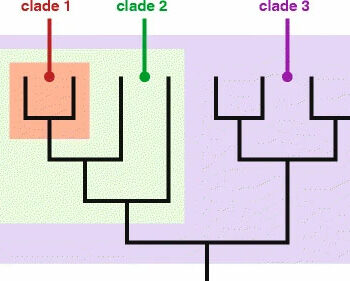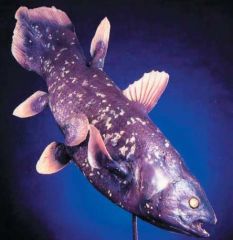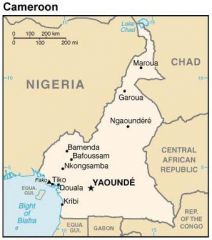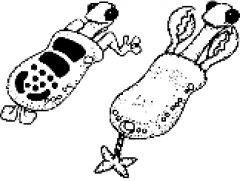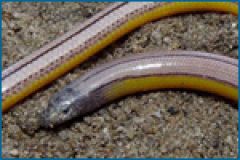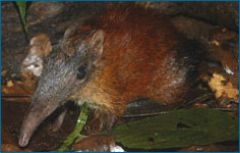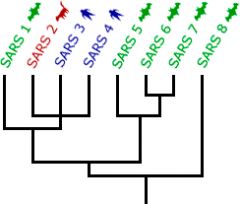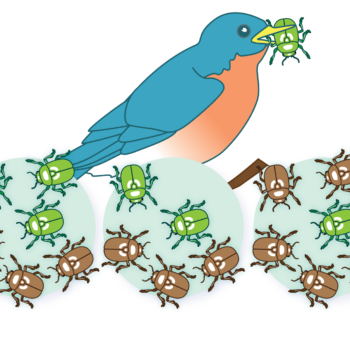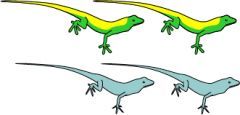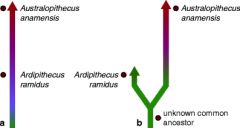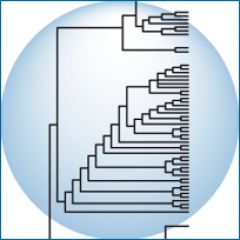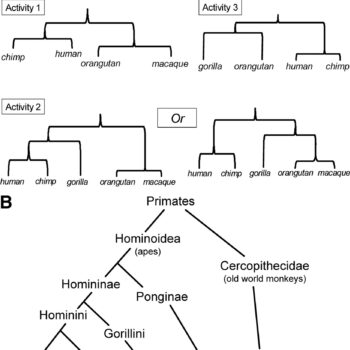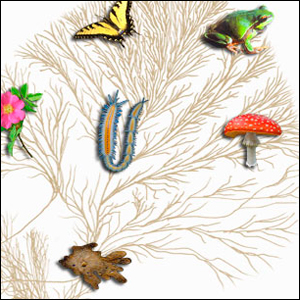Found 16 resources for:
classification
A name by any other tree
Grade Level(s):
- 6-8
- 9-12
- 13-16
- General
Source:
- Evolution: Education and Outreach
Resource type:
- Article
Time: 35 minutes
Overview
Phylogenetics has affected almost every area of biology - even the most basic one: how we classify organisms. Find out how phylogenetic classification works and what its advantages are.
This article appears at SpringerLink.
View details >>
A Strange Fish Indeed: The “Discovery” of a Living Fossil
Grade Level(s):
- 9-12
- 13-16
Source:
- Grant, Robert
Resource type:
- Classroom activity
Time: 50-90 min.
Overview
Through a series of fictionalized diary entries, this case recounts the 1939 discovery by Marjorie Courtenay-Latimer (and identification by J.L.B. Smith) of a living coelacanth, a fish believed to have been extinct for 70 million years.
View details >>
An Antipodal Mystery
Grade Level(s):
- 9-12
- 13-16
Source:
- Herreid, Clyde Freeman
Resource type:
- Classroom activity
Time: 1 to 2 hours, ideally split over multiple class periods
Overview
The discovery of the platypus had the scientific world in an uproar with its mammal-like and bird-like features. How was one to classify the platypus? This case study uses this issue to model the scientific process, with scientists arguing, debating, collecting more evidence, and revising their opinions as new data become available.
View details >>
Chimpanzee Droppings Lead Scientists to Evolutionary Discovery
Grade Level(s):
- 13-16
Source:
- Kosal, Erica F.
Resource type:
- Classroom activity
Time: 1.5 to 2 hours
Overview
Simian Immunodeficiency Virus (SIV) is thought to be a precursor to HIV. This multi-part case study explores changes in SIV in different chimpanzee populations and how researchers use this information to test hypotheses about the origins of HIV.
View details >>
Classification and Evolution
Grade Level(s):
- 9-12
- 13-16
Source:
- Gendron, Robert
Resource type:
- Lab activity
Time: Two class periods.
Overview
Students construct an evolutionary tree of imaginary animals (Caminalcules) to illustrate how modern classification schemes attempt to reflect evolutionary history.
View details >>
Evo in the news: The legless lizards of LAX
Grade Level(s):
- 9-12
- 13-16
- General
Source:
- UC Museum of Paleontology
Resource type:
- Evo in the News article
Time: 20 minutes
Overview
This news brief from October 2013 describes the discovery of four new species of legless lizard. Why don't we just call these animals snakes? Because of their evolutionary history...
View details >>
Evo in the news: The new shrew that’s not
Grade Level(s):
- 9-12
- 13-16
- General
Source:
- UC Museum of Paleontology
Resource type:
- Evo in the News article
Time: 20 minutes
Overview
This news brief from March of 2008 describes scientists' discovery of a new mammal species, a giant elephant shrew. Though elephant shrews resemble regular shrews, recent genetic evidence suggests that elephant shrews actually sprang from a much older (and perhaps more charismatic) branch of the tree of life - the one belonging to elephants and their relatives.
View details >>
Evo in the news: Tracking SARS back to its source
Grade Level(s):
- 9-12
- 13-16
- General
Source:
- UC Museum of Paleontology
Resource type:
- Evo in the News article
Time: 15 minutes
Overview
This news brief, from January of 2006, traces the source of the SARS virus. Using phylogenetics, biologists have come up with a plausible path of transmission which may help us prevent future outbreaks of diseases such as HIV, SARS, and West Nile virus.
View details >>
Evolución 101
Grade Level(s):
- 9-12
- 13-16
- General
Source:
- UC Museum of Paleontology
Resource type:
- Article
Overview
¿Qué es la evolución y cómo funciona? Introducción a la evolución ofrece información detallada y práctica sobre los patrones y los mecanismos de la evolución.
View details >>
Island biogeography and evolution: Solving a phylogenetic puzzle using molecular genetics
Grade Level(s):
- 9-12
- 13-16
Source:
- Filson, R.P.
Resource type:
- Lab activity
Time: Two full class periods
Overview
Students focus on the evolution of three species of lizards using real data sets — geographical and geological data, then morphology, and finally molecular data — to determine possible phylogenetic explanations.
View details >>
Monkey opsins
Grade Level(s):
- 13-16
Source:
- Evo-Ed
Resource type:
- Case study
Time: Two class periods
Overview
This case study in the form of a set of PowerPoint slides examines the evolution of trichromatic vision in old world monkeys.
View details >>
Names, they are a-changing
Grade Level(s):
- 9-12
- 13-16
Source:
- Evolution: Education and Outreach
Resource type:
- Article
Time: 30 minutes
Overview
The popular press often describes scientific controversies regarding which species ancient hominin fossils represent and how they are related to one another. How should students interpret the frequent name changes experienced by our extinct relatives? What should they make of headlines that trumpet major revisions of the branching patterns on our limb of the tree of life? This article will help teachers develop instruction surrounding these issues, discourage misconceptions, and help students interpret media coverage in light of the process of science.
This article appears at SpringerLink.
View details >>
Phylogenetic systematics, a.k.a. evolutionary trees
Grade Level(s):
- 13-16
- Advanced
- General
Source:
- UC Museum of Paleontology
Resource type:
- Tutorial
Time: 20 minutes
Overview
Learn about phylogenetic systematics, the study of the evolutionary relationships among organisms, and how the field is shaping biological research today.
View details >>
Teaching the Process of Molecular Phylogeny and Systematics: A Multi-Part Inquiry-Based Exercise
Grade Level(s):
- 9-12
- 13-16
Source:
- Lents, Nathan, et al
Resource type:
- Lab activity
Time: 1 to 4 periods
Overview
Students explore molecular data from Homo sapiens and four related primates and develop hypotheses regarding the ancestry of these five species by analyzing DNA sequences, protein sequences, and chromosomal maps.
View details >>
Tree of Life
Grade Level(s):
- 9-12
- 13-16
Source:
- Tree of Life
Resource type:
- Interactive
Time: 1 class period
Overview
This interactive web resource allows you to follow any branch on the tree of life to find out how scientists hypothesize all the species on Earth (plus some extinct lineages) are related to one another.
This resource appears at the Tree of Life website.
View details >>
Using trees to understand plants: The work of Chelsea Specht
Grade Level(s):
- 9-12
- 13-16
- General
Source:
- UC Museum of Paleontology
Resource type:
- Research profile
Time: 30 minutes
Overview
This research profile follows scientist Chelsea Specht as she pieces together the evolutionary history of tropical plants and their pollinators--and in the process, tries to figure out how to conserve endangered species.
View details >>

